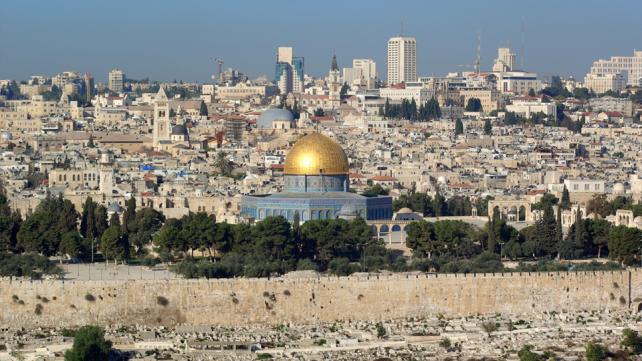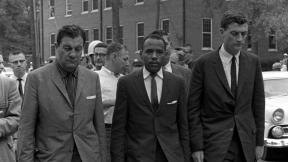
If you think racism, as indicated by things like the 1994 O. J. Simpson trial, the 1992 race riots in Los Angeles, or the existence of the white supremacist group the Ku Klux Klan in America is something new, think again.
Racism existed before and during the lifetime of the Prophet Muhammad (peace and blessings be upon him), during the time of the Companions, and they devised strategies to combat it.
Here are some examples from the Muslims' past and present that testify to the dynamics of Islamic egalitarianism.
Who will enter the Kaba first with the Prophet (Year 629)
Ponder this: when the Muslims conquered Makkah, victorious after years of persecution, then war with the non-believing Quraysh, the Prophet went straight to the Kaba.
This was the height of the victory of Islam. He brought some other Muslims with him. He could have chosen only Muslims from the Quraysh, people of his own ethnic and tribal background. He also could have chosen only Arabs or only those of the old noble classes.
But two of the people who entered the Kaba with the Prophet were Bilal ibn Rabah and Zaid ibn Haritha. Bilal, an African and a former slave. Zaid was also not of high status from the tribal Quraysh point of view. Then entered a Qurayshi, Abdullah bin Omar, may Allah be pleased with all of them.
On this day of victory, success and happiness was for all Muslims, no matter who they were or where they come from.
This black man is our leader (Year 634)
When the Muslims conquered Egypt at the time when Omar ibn al Khattab (may Allah be pleased with him) was Khalifa, a Muslim leader who happened to be a black man named Ubaydah ibn Thamit, took a party of the Muslims to meet Muqawqis, the Christian leader of Egypt.
When the Muslims came to Muqawqis, with Ubaydah in the lead, Muqawqis was frightened by the color of his skin.
‘Get this black man away from me and bring someone else,' he demanded. The Muslims refused. They insisted that Ubaydah was the best among them and was their leader who they obeyed and whose judgment they deferred to. They told Muqawqis that the color of a person does not matter to them. Finally Muqawqis had no choice but talk to the leader of that Muslim delegation.
These Muslims were practicing an Islamic principle that individual character is the base of preference not color of skin.
The Conquests of Jerusalem - a Study in Contrasts
Jerusalem and its surrounding territory were and remain holy to Muslims, Christians and Jews. It was during the Caliphate of Omar ibn al-Khattab (634-635) that Muslims first gained leadership of this territory. May Allah be pleased with him.
The Muslim reaction to this victory is something to remember.
Omar entered Jerusalem in humility. He walked in with not he, the Caliph, but his servent comfortably riding on a camel. They had been taking turns walking and riding.
At one point, the Christians asked him to pray in their church but he declined. He refused saying that he is afraid that in the future Muslims could use it as an excuse to take over the Church for building a Masjid.
The Christians gave the key of the Church of Resurrection to Muslims to be responsible for its safety. This key is still with the Muslims today.
In contrast, during the Crusades (1095 until 1291) European Christians attacked and occupied this holy land. They oppressed the Muslims, the local Christians and the Jews. These Crusaders killed over 200,000 innocent civilians.
It was in response to this horrific oppression and the need to free the area of Crusader control that Sultan Salah el Deen Ayyubi (Saladin) liberated Jerusalem from them in 1187.
His arrival brought relief for the local Christian population, who helped him, after the oppression they suffered at the hands of their co-religionists, the Crusaders.
Not only did Salah el Deen treat the Crusaders with kindness, and ensured that Muslim and non-Muslims live in peace and harmony with each other.
One particular story about him recounts that some Muslim soldiers were besieging a Christian fortress. Many Christians were seeking shelter inside, including a young couple who was planning to get married, but whose plans had been stopped by the fighting. They decided to get married anyway, even though they were trapped inside the castle.
Salah el Deen was in charge of the Muslim troops at this time. When he heard about the wedding, he ordered his soldiers not to attack the castle where the couple was staying, so that they could enjoy peace and quiet. In return for this respect, the bride's mother sent out trays of food, so Salah el Deen and the Muslim army could share in the wedding celebrations.
Indeed the best period of peace and justice for all in Jerusalem has been the period when Muslim were in control.
Muslim Spain versus Christian Spain: Civilization versus Inquisition
Many Muslims look back at Muslim Spain with pride. But few people know that Jews also call it their "golden era".
Spain became part of the Islamic world at the beginning of the eighth century. Under Muslims Spain became the center of civilization. Although many local Spaniards embraced Islam, Christians and Jews were free in all aspects of their lives. The Muslims respected their religion and institutions. The result was the birth of the first true cosmopolitan culture in the West.
Christians studied alongside Muslim scholars to such a degree that in 854, a Christian named Alvaro of Cordoba complained that these students were forgetting their own religion and culture.
Muslims and Christians of Spain did not live in their ghettos, isolated and not cooperating in various aspects of daily life together.
One manifestation of this cooperation can be found inside the Great Mosque at Cordoba.
Skilled Christian craftsmen, who were trained in Constantinople (which is the city of Istanbul in Turkey today), made beautiful mosaic panels for the walls of the mosque. The Christians worked along with the Muslims to decorate the interior of the mosque with colors and design.
Cordoba was not just the pride of the Muslim world though. The city under Muslim rule was famous throughout Europe.
One Christian nun named Hrosvitha who lived in the 10th century described Cordoba from her home in Germany as the ‘jewel of the world-a city well-cultured, rich... abounding in knowledge.'
It's not surprising that Hrosvitha described the city in this way. Muslim Spain was the center of science and arts. Muslims and Jewish authors wrote many important treatises about science in Arabic. Many ancient Greek texts also survived because Muslims translated them into Arabic.
For example, Aristotle's works on physics and natural history were translated into Arabic from Greek in Muslim Spain. Historians generally acknowledge that the Muslim world proved to be a major conduit of ancient scholarship into the West, especially through Muslim Spain.
It wasn't just Muslims and Christians who thrived in Spain, though. Jews, who were reviled and hated elsewhere, were not only living safely and peacefully alongside non-Jews in Muslim Spain, they were learning and contributing to its culture and knowledge which Muslim scholars had established.
One instance of this is the famous Spanish Jewish scholar, Moses Maimonides (1135-1204) who wrote in Arabic as well as Hebrew.
But this success in wealth, knowledge and co-existence came to end in a violent and very sad way.
As Christian Crusaders of Spain expelled Muslims, civilization that took centuries to build was destroyed. Muslims and Jews were either expelled or forced to convert to Christianity. Millions died as tolerance was replaced by the Inquisition. A suspected Muslim was to be killed for the smallest act resembling Islamic tradition - such as taking a bath on Friday.
Muslims in Bosnia: The Multi ethnic ideals versus racio-nationalism of Serbs (1992-95)
Bosnia is another bright example of Islamic, non-racial egalitarianism and tolerance in Europe. Bosnia today stands as an example of the principle of a multi ethnic society which refused to submit to the racial ideals and attacks of Serb nationalism.
Islam came to Bosnia in 1463 under Ottoman Turks. During Ottoman rule, many Bosnians embraced Islam. Bosnia remained under Ottoman rule until 1878, when it was given to Austria-Hungary as a colony.
While those living in Bosnia enjoyed the benefits of the Austro-Hungarian Empire, South Slavs in Serbia and elsewhere were calling for a South Slav state. World War I began when Serb nationalist Gavrilo Princip assassinated the Archduke Ferdinand in Sarajevo. After the war, Bosnia became part of the South Slav state of Yugoslavia.
It was given to Croatia in World War II and during the Cold War the Communist Federal Republic of Yugoslavia was established under Josef Tito. Bosnia was reestablished as a republic with its medieval borders.
Yugoslavia's unraveling was hastened by the rise of Slobodan Milosevic to power in 1986. Milosevic's embrace of the Serb nationalist agenda led to intrastate ethnic strife. Slovenia and Croatia both declared independence in 1991, and Bosnia-Herzegovina soon followed.
In February 1992, the Bosnian Government held a referendum on independence for all people living in Bosnia. Bosnian Serbs, supported by neighboring Serbia, responded with armed resistance aiming to partition the republic along ethnic lines in an attempt to create a "greater Serbia."
In April 1992, Bosnia and Herzegovina was the most ethnically diverse of the Yugoslav republics, According to a Yugoslavian census in 1991, Bosnia was 43.7% Muslim, 31.4% Serbian, and 17.3% Croatian.
The Bosnians resisted the genocidal Serb attacks despite the arms embargo, through most of 1995, ending with the Dayton Accord, signed on November 21, 1995 which retains the multiethnic ideals which Bosnians cherished. However, because of the way Dayton accord is designed, this freedom is more a nightmare than a dream come true.
This was the worst case of genocide in Europe since World War II. 250,000 people were killed and 2 million people became homeless resisting the Serb's nationalism and racism to cherish the ideals that all human being can live together. This was a principled defense lead by Dr. Alija Ali Izetbegovich.
Conclusion
These are just a few examples from Muslim history, which are closer to the Islamic ideals of all humanity being one. This is by no means a claim that all Muslims have always behaved in the most ideal way. Muslims like other human beings are fully capable of falling short in their practice of these ideals. One can come up with a whole set of examples in which tribalism and nationalism have resulted in an unIslamic behavior among Muslims. Muslims as a whole have never condoned or embraced the personal behavior or ideologies which are based on color or race. Islamic ideals continue to challenge racial and national ideologies by inspiring Muslims to emulate the model of the Prophet, may Allah's peace and blessings be upon him.
Photo Attribution: "Jerusalem Dome of the rock BW 14" by Berthold Werner - Own work. Licensed under Public domain via Wikimedia Commons - http://commons.wikimedia.org/wiki/File:Jerusalem_Dome_of_the_rock_BW_14.JPG#mediaviewer/File:Jerusalem_Dome_of_the_rock_BW_14.JPG








Comments
Excellent Article, Jazakallahukhair
Location
Extremely informative. Please I want to email this to others but how?
Location
Very good report on how integration should work in the world. As it happend before.But lets not forget that natioanlism is also necessary for survival of a nation. Nationalism not racism. On the other hand conquerors/immigrants should abstain of spreading their ideology.
Location
Add new comment